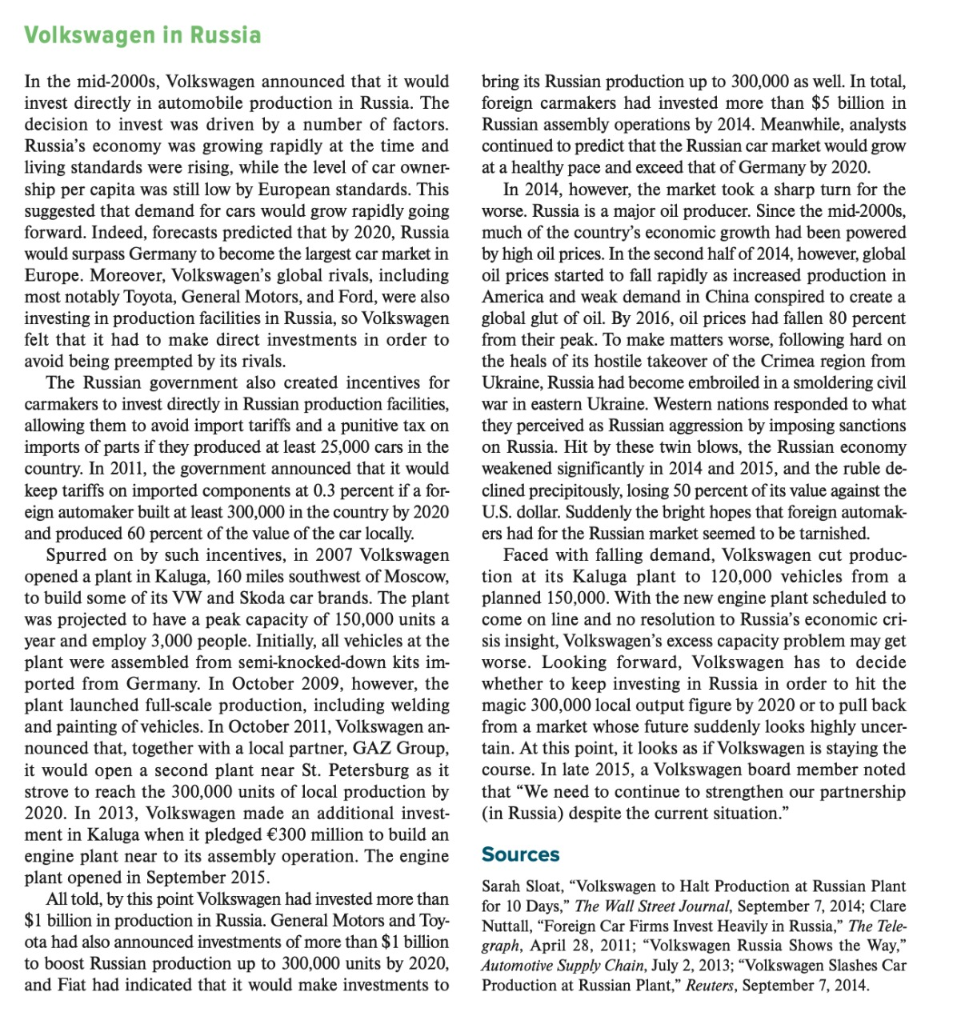Avoid plagiarism .. I need answers in your own words, please.
Case study
Please read Case 8: Volkswagen in Russia available in your e-book (page no.619), and answer the following questions:

Assignment Question(s): (Marks: 5)
- What factors underlay the decision by Volkswagen to invest directly in automobile production in Russia? Why was FDI preferable to exporting from existing factories in Germany?
- Which theory (or theories) of FDI best explain Volkswagens FDI in Russia?
- How do you think FDI by foreign automobile companies might benefit the Russian economy? Is there any potential downside to Russia from this inflow of FDI?
- Russia is largely dependent on oil exports to drive its economy forward. Given the sharp fall in global oil prices that occurred in 2014 and 2015, what impact do you think this will have on FDI into Russia?
- Volkswagen has signaled that it is going to stay the course in Russia, despite current political and economic headwinds. Why do you think it made this decision? What are the pros and cons of this decision? In your opinion, is it the correct decision?
Volkswagen in Russia In the mid-2000s, Volkswagen announced that it would invest directly in automobile production in Russia. The decision to invest was driven by a number of factors. Russia's economy was growing rapidly at the time and living standards were rising, while the level of car owner- ship per capita was still low by European standards. This suggested that demand for cars would grow rapidly going forward. Indeed, forecasts predicted that by 2020, Russia would surpass Germany to become the largest car market in Europe. Moreover, Volkswagen's global rivals, including most notably Toyota, General Motors, and Ford, were also investing in production facilities in Russia, so Volkswagen felt that it had to make direct investments in order to avoid being preempted by its rivals. The Russian government also created incentives for carmakers to invest directly in Russian production facilities, allowing them to avoid import tariffs and a punitive tax on imports of parts if they produced at least 25,000 cars in the country. In 2011, the government announced that it would keep tariffs on imported components at 0.3 percent if a for- eign automaker built at least 300,000 in the country by 2020 and produced 60 percent of the value of the car locally. Spurred on by such incentives, in 2007 Volkswagen opened a plant in Kaluga, 160 miles southwest of Moscow, to build some of its VW and Skoda car brands. The plant was projected to have a peak capacity of 150,000 units a year and employ 3,000 people. Initially, all vehicles at the plant were assembled from semi-knocked-down kits im- ported from Germany. In October 2009, however, the plant launched full-scale production, including welding and painting of vehicles. In October 2011, Volkswagen an- nounced that, together with a local partner, GAZ Group, it would open a second plant near St. Petersburg as it strove to reach the 300,000 units of local production by 2020. In 2013, Volkswagen made an additional invest- ment in Kaluga when it pledged 300 million to build an engine plant near to its assembly operation. The engine plant opened in September 2015. All told, by this point Volkswagen had invested more than $1 billion in production in Russia. General Motors and Toy- ota had also announced investments of more than $1 billion to boost Russian production up to 300,000 units by 2020, and Fiat had indicated that it would make investments to bring its Russian production up to 300,000 as well. In total, foreign carmakers had invested more than $5 billion in Russian assembly operations by 2014. Meanwhile, analysts continued to predict that the Russian car market would grow at a healthy pace and exceed that of Germany by 2020. In 2014, however, the market took a sharp turn for the worse. Russia is a major oil producer. Since the mid-2000s, much of the country's economic growth had been powered by high oil prices. In the second half of 2014, however, global oil prices started to fall rapidly as increased production in America and weak demand in China conspired to create a global glut of oil. By 2016, oil prices had fallen 80 percent from their peak. To make matters worse, following hard on the heals of its hostile takeover of the Crimea region from Ukraine, Russia had become embroiled in a smoldering civil war in eastern Ukraine. Western nations responded to what they perceived as Russian aggression by imposing sanctions on Russia. Hit by these twin blows, the Russian economy weakened significantly in 2014 and 2015, and the ruble de- clined precipitously, losing 50 percent of its value against the U.S. dollar. Suddenly the bright hopes that foreign automak- ers had for the Russian market seemed to be tarnished. Faced with falling demand, Volkswagen cut produc- tion at its Kaluga plant to 120,000 vehicles from a planned 150,000. With the new engine plant scheduled to come on line and no resolution to Russia's economic cri- sis insight, Volkswagen's excess capacity problem may get worse. Looking forward, Volkswagen has to decide whether to keep investing in Russia in order to hit the magic 300,000 local output figure by 2020 or to pull back from a market whose future suddenly looks highly uncer- tain. At this point, it looks as if Volkswagen is staying the course. In late 2015, a Volkswagen board member noted that "We need to continue to strengthen our partnership (in Russia) despite the current situation." Sources Sarah Sloat, Volkswagen to Halt Production at Russian Plant for 10 Days," The Wall Street Journal, September 7, 2014; Clare Nuttall, Foreign Car Firms Invest Heavily in Russia," The Tele- graph, April 28, 2011; Volkswagen Russia Shows the Way," Automotive Supply Chain, July 2, 2013; "Volkswagen Slashes Car Production at Russian Plant, Reuters, September 7, 2014







